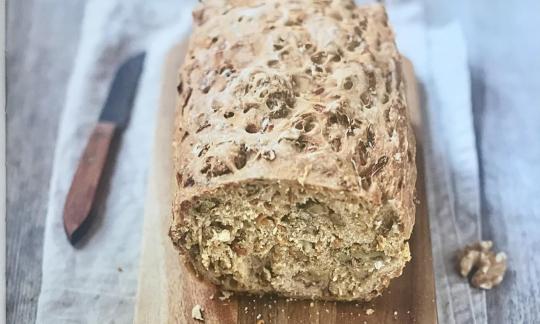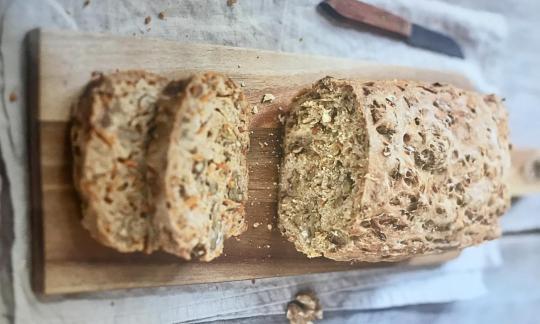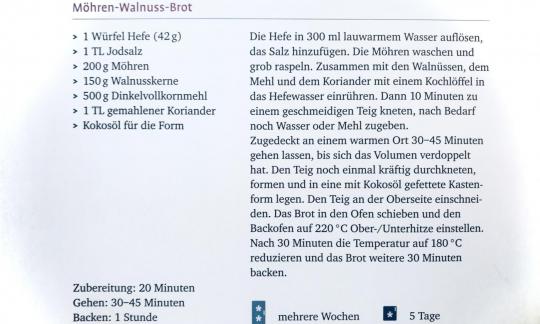Carrot-Walnut Bread with Ground Coriander
vegan
Ingredients (for servings, )
| 1 ½ oz | Fresh baking yeast (pressed yeast, baker’s yeast) |
| 300 ml | Drinking water, raw (organic?) (11 oz) |
| 1 tsp | Table salt (table salt, raw?, organic?) (0.21 oz) |
| 7 ⅓ oz | Carrots (carrots), raw (organic?) |
| 5 ½ oz | Walnuts (tree nuts), raw (organic?) |
| 18 oz | Wholemeal spelt flour (organic?) |
| 1 tsp, ground | Real coriander, seeds (raw?, organic?) (0.08 oz) |
| ¼ tsp | Coconut oil (coconut oil, coconut fat, organic?, raw?) (0.04 oz) |
Equipment
- food processor
- grater
- baking pan (springform pan)
- oven
Type of preparation
- bake
- chop or grind
- meld
- grate (shred)
- knead
Preparation
Preparation of the yeast
Dissolve the yeast in the specified amount of lukewarm water and add the salt.Preparing the other ingredients
Wash the carrots and grate them coarsely. Roughly chop the walnuts.The original recipe doesn't say anything about chopping the walnuts. However, they seem a bit too big to us as walnut halves, so we chop them additionally.
finishing the dough
Using a wooden spoon, stir grated carrots and walnuts together with the flour and ground coriander into yeast water.You can use a food processor to knead.
Then knead for 10 minutes until you have a smooth dough. Add more water or flour if necessary.
Leave to rise in a warm place for 30-45 minutes until the volume has doubled.Knead the dough again vigorously, shape it and place it in a loaf pan greased with coconut oil.
Cut the dough along the top.Alternatively, you can also form a loaf of bread and then place it on a baking tray lined with baking paper and bake it.
Put the bread in the oven and set the oven to 220 °C top/bottom heat. After 30 minutes, reduce the temperature to 180 °C and bake the bread for another 30 minutes.
Shelf life: The bread will last for 5 days in the refrigerator and several weeks when frozen.
|
Nutritional Information per person
Convert per 100g
|
2000 kcal | |
|---|---|---|
| Energy | 463 kcal | 23.1% |
| Fat/Lipids | 18 g | 25.9% |
| Saturated Fats | 2.0 g | 9.8% |
| Carbohydrates (inc.dietary fiber) | 66 g | 24.6% |
| Sugars | 3.0 g | 3.3% |
| Fiber | 12 g | 46.7% |
| Protein/Albumin | 16 g | 32.8% |
| Cooking Salt (Na:415.9 mg) | 1'056 mg | 44.0% |
| Essential micronutrients with the highest proportions | per person | 2000 kcal | |
|---|---|---|---|
| Min | Manganese, Mn | 3.7 mg | 184.0% |
| Fat | Alpha-Linolenic acid; ALA; 18:3 omega-3 | 2.3 g | 114.0% |
| Fat | Linoleic acid; LA; 18:2 omega-6 | 10 g | 104.0% |
| Min | Copper, Cu | 0.85 mg | 85.0% |
| Prot | Tryptophan (Trp, W) | 0.19 g | 76.0% |
| Prot | Threonine (Thr, T) | 0.62 g | 67.0% |
| Min | Iron, Fe | 9.2 mg | 66.0% |
| Vit | Folate, as the active form of folic acid (née vitamin B9 and | 127 µg | 64.0% |
| Vit | Thiamine (vitamin B1) | 0.66 mg | 60.0% |
| Elem | Phosphorus, P | 362 mg | 52.0% |
Detailed Nutritional Information per Person for this Recipe
The majority of the nutritional information comes from the USDA (US Department of Agriculture). This means that the information for natural products is often incomplete or only given within broader categories, whereas in most cases products made from these have more complete information displayed.
If we take flaxseed, for example, the important essential amino acid ALA (omega-3) is only included in an overarching category whereas for flaxseed oil ALA is listed specifically. In time, we will be able to change this, but it will require a lot of work. An “i” appears behind ingredients that have been adjusted and an explanation appears when you hover over this symbol.
For Erb Muesli, the original calculations resulted in 48 % of the daily requirement of ALA — but with the correction, we see that the muesli actually covers >100 % of the necessary recommendation for the omega-3 fatty acid ALA. Our goal is to eventually be able to compare the nutritional value of our recipes with those that are used in conventional western lifestyles.
| Essential fatty acids | per person | 2000 kcal |
|---|---|---|
| Alpha-Linolenic acid; ALA; 18:3 omega-3 | 2.3 g | 114.0% |
| Linoleic acid; LA; 18:2 omega-6 | 10 g | 104.0% |
| Essential amino acids | per person | 2000 kcal |
|---|---|---|
| Tryptophan (Trp, W) | 0.19 g | 76.0% |
| Threonine (Thr, T) | 0.62 g | 67.0% |
| Isoleucine (Ile, I) | 0.63 g | 51.0% |
| Phenylalanine (Phe, F) | 0.80 g | 51.0% |
| Leucine (Leu, L) | 1.1 g | 47.0% |
| Valine (Val, V) | 0.74 g | 46.0% |
| Methionine (Met, M) | 0.25 g | 27.0% |
| Lysine (Lys, K) | 0.45 g | 24.0% |
| Vitamins | per person | 2000 kcal |
|---|---|---|
| Folate, as the active form of folic acid (née vitamin B9 and | 127 µg | 64.0% |
| Thiamine (vitamin B1) | 0.66 mg | 60.0% |
| Vitamin A, as RAE | 279 µg | 35.0% |
| Niacin (née vitamin B3) | 5.0 mg | 31.0% |
| Biotin (ex vitamin B7, H) | 16 µg | 31.0% |
| Vitamin B6 (pyridoxine) | 0.38 mg | 27.0% |
| Pantothenic acid (vitamin B5) | 1.6 mg | 26.0% |
| Vitamin E, as a-TEs | 1.6 mg | 13.0% |
| Riboflavin (vitamin B2) | 0.14 mg | 10.0% |
| Vitamin K | 5.1 µg | 7.0% |
| Vitamin C (ascorbic acid) | 2.4 mg | 3.0% |
| Vitamin B12 (Cobalamin) | 0.00 µg | < 0.1% |
| Essential macroelements (macronutrients) | per person | 2000 kcal |
|---|---|---|
| Phosphorus, P | 362 mg | 52.0% |
| Sodium, Na | 416 mg | 52.0% |
| Magnesium, Mg | 139 mg | 37.0% |
| Potassium, K | 603 mg | 30.0% |
| Calcium, Ca | 48 mg | 6.0% |
| Essential trace elements (micronutrients) | per person | 2000 kcal |
|---|---|---|
| Manganese, Mn | 3.7 mg | 184.0% |
| Copper, Cu | 0.85 mg | 85.0% |
| Iron, Fe | 9.2 mg | 66.0% |
| Zinc, Zn | 4.4 mg | 44.0% |
| Selenium, Se | 1.9 µg | 4.0% |
| Iod, I (Jod, J) | 2.4 µg | 2.0% |
| Fluorine, F | 37 µg | 1.0% |
The carrot-walnut bread with ground coriander is prepared with wholemeal spelt flour.
Serving size: The specified amount for 6 servings makes 1 loaf.
Nutrient profile: According to GDA guidelines, one portion covers far more than the average daily requirement of manganese and the essential omega-3 fatty acid. Tryptophan, iron and folic acid are covered by over 50%.
The ratio of omega-6 to omega-3 fatty acids is 5:1, which is within the maximum recommended ratio. Read more at: Vegans often eat unhealthily. Avoidable nutritional errors.
However, the vegetables lose some of their nutrients when heated during cooking and baking. Since the nutrient profile primarily refers to uncooked ingredients, the values are actually somewhat lower.
Walnuts: In addition to preparing and refining various dishes and desserts, walnuts are also used to make walnut oil. Of all known nuts, walnuts have the highest proportion of alpha-linolenic acid. They also have health benefits thanks to their high levels of tocopherols (forms of vitamin E) and many other trace elements.
Spelt flour: Spelt is closely related to wheat and is therefore often called "ancient wheat". Spelt flour is available as type 630, type 812 and type 1050, with the flour type indicating how many minerals are contained per 100 grams of flour. Flours with a high type number are generally richer and healthier. Spelt is also available in the form of wholemeal flour. Spelt flour 630 has comparatively good baking properties and can often be used instead of wheat flour. Differences between spelt and wheat in terms of ingredients are marginal, only the silica content of spelt is significantly higher than that of wheat.
Coriander seeds: Among others, linalool and geraniol are responsible for the pleasant smell of coriander seeds, which only becomes apparent after drying.
Shelf life: The bread will last for 5 days in the refrigerator and several weeks when frozen.
Instead of the fresh yeast specified, you can also usedry yeast.
Instead of wholemeal spelt flour, you can use wholemeal wheat flour. There are hardly any differences in terms of ingredients (see notes).
You can replace the coconut oil for greasing with any heat-stable oil.







